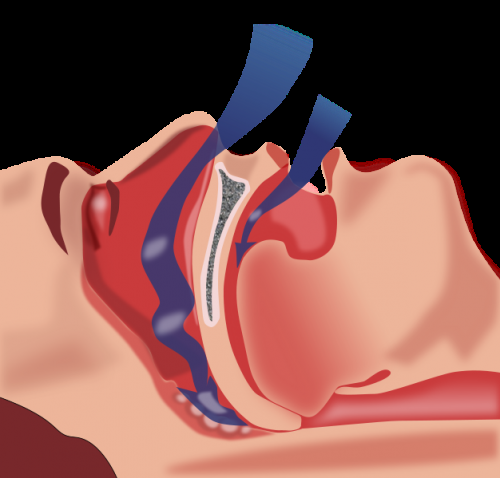Synthetic cannabinoid reduces sleep apnea

A synthetic version of a molecule found in the cannabis plant was safe and effective in treating obstructive sleep apnea in the first large, multi-site study of a drug for the sleep disorder funded by the National Institutes of Health. The study was conducted at the University of Illinois at Chicago and Northwestern Medicine.
There currently is no drug treatment for sleep apnea, a sleep breathing disorder affecting about 30 million individuals in the United States and linked to numerous health problems. In sleep apnea, breathing is interrupted. These pauses can last from a few seconds to several minutes and can occur 30 times or more in an hour. Untreated sleep apnea raises the risk of heart disease, diabetes, sleepiness and cognitive impairment, as well as the risk of having a motor vehicle accident.
The common treatment for sleep apnea is a continuous positive airway pressure device, or CPAP, that is worn during sleep and forces air into the lungs to prevent breathing pauses. But long-term adherence to the device is poor and many patients simply stop using it.
Researchers investigated the effect of dronabinol, a synthetic version of the molecule tetrahydrocannabinol, or Delta-9 THC, which is found in cannabis, on sleep apnea in a Phase 2 clinical trial – the largest and longest randomized, controlled trial to test a drug to treat sleep apnea. The drug was approved by the Food and Drug Administration more than 25 years ago to treat nausea and vomiting in chemotherapy patients.
Their findings were published recently in the journal Sleep.
"There is a tremendous need for effective, new treatments in obstructive sleep apnea," said study co-lead David Carley, Katherine M. Minnich Endowed Professor Emeritus of biobehavioral health sciences, medicine and bioengineering at the University of Illinois at Chicago and co-lead author on the paper.
The drug treatment reflects the idea that sleep apnea is not just a physical problem but may be caused by multiple factors, including poor regulation of the upper airway muscles by the brain, said co-lead author Dr. Phyllis Zee, the Benjamin and Virginia T. Boshes Professor of Neurology at Northwestern University Feinberg School of Medicine and director of the Northwestern Medicine Sleep Disorders Center.
"The CPAP device targets the physical problem but not the cause," Zee said. "The drug targets the brain and nerves that regulate the upper airway muscles. It alters the neurotransmitters from the brain that communicate with the muscles. Better understanding of this will help us develop more effective and personalized treatments for sleep apnea."
Some patients refuse to use the CPAP breathing machine, Carley said. Even people who want to use it often only stick with it for about four hours a night, on average.
"So, the best they get is a roughly 50 percent improvement in their apnea. So far, it's an impenetrable problem," Carley said. "When people take a pill to treat apnea, they are treated for the entire night."
Carley developed the idea that dronabinol might be useful in treating sleep apnea more than 15 years ago. He and colleagues tested the concept in an animal model of apnea, publishing their findings in the journal SLEEP in 2002 and launched a subsequent pilot study in humans in 2007. Encouraging findings from the small-scale pilot study formed the basis for this multi-center clinical trial led by Carley and Zee.
In the current study, 73 adult patients with moderate or severe sleep apnea were divided into three groups. One group was given a low dose of dronabinol, a second group received a higher dose, and the third, a placebo. Participants took the drug once daily before bed for six weeks.
Six weeks of treatment by the highest dose of dronabinol (10 milligrams) was associated with a lower frequency of apneas or hypopneas (very shallow breathing) during sleep, decreased subjective sleepiness and greater overall treatment satisfaction compared to the placebo group. Ten milligrams of dronabinol was about 33 percent as effective in treating sleep apnea as all-night use of CPAP, but total compliance with CPAP is extremely rare, Carley explained.
But can a person simply ingest or smoke marijuana and get the same benefits for sleep apnea?
No, said Zee. "Different types of cannabis have different ingredients," she noted. "The active ingredient may not be exactly the same as what's indicated for sleep apnea."
"Cannabis contains dozens of active ingredients, but we tested just purified Delta-9 THC," added Carley.
Larger scale clinical trials are needed to clarify the best approach to cannabinoid therapy in obstructive sleep apnea, the researchers said.
UIC has licensed intellectual property related to the experimental drug treatment used in the study to the pharmaceutical company RespireRx.
Researchers have attempted to identify drugs to treat sleep apnea for nearly 35 years, but to no avail, Carley explained.
"By providing a path toward the first viable obstructive sleep apnea drug, our studies could have a major impact on clinical practice," he said.
More information: David W Carley et al. Pharmacotherapy of Apnea by Cannabimimetic Enhancement, the PACE Clinical Trial: Effects of Dronabinol in Obstructive Sleep Apnea, Sleep (2017). DOI: 10.1093/sleep/zsx184

















